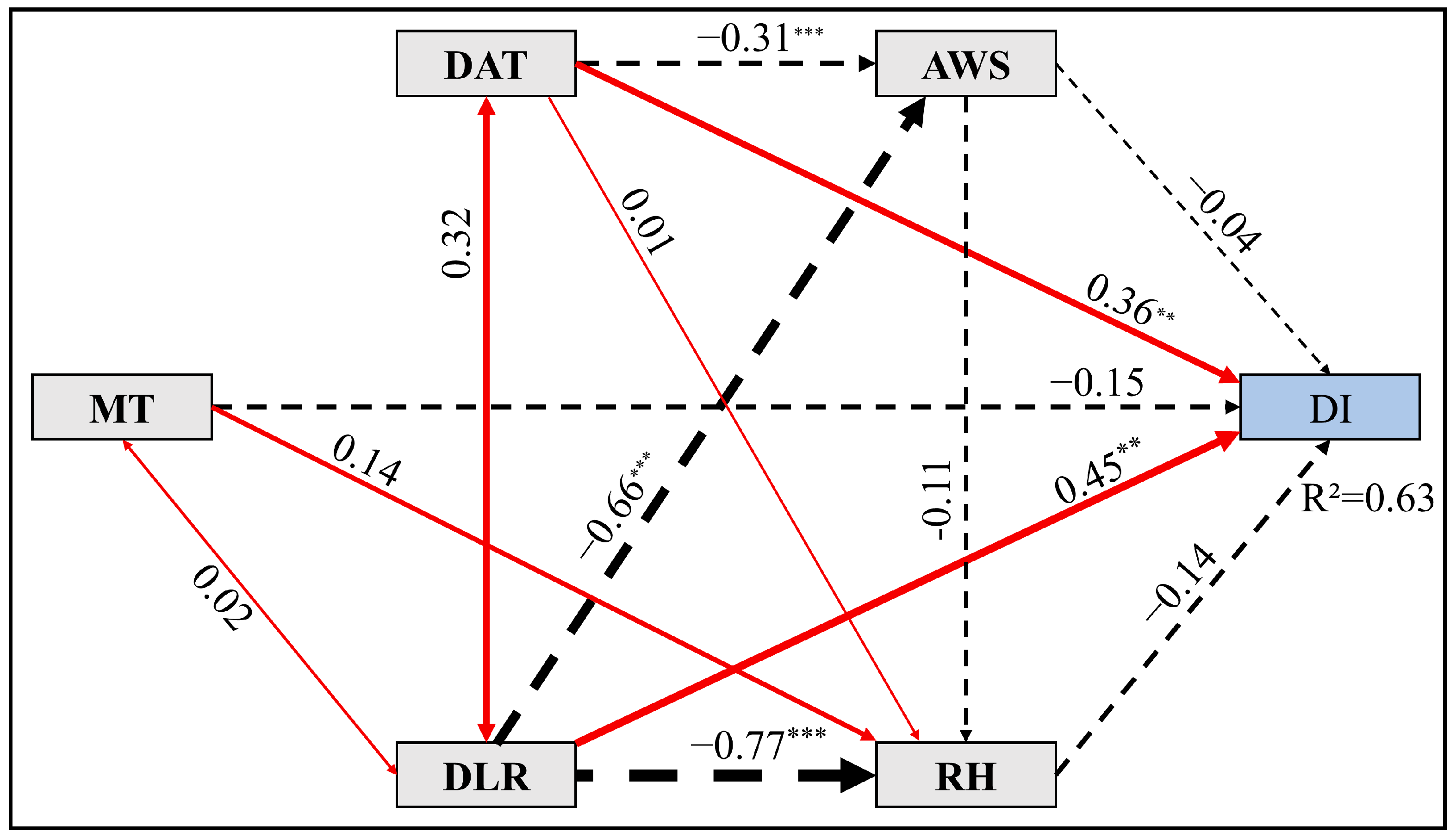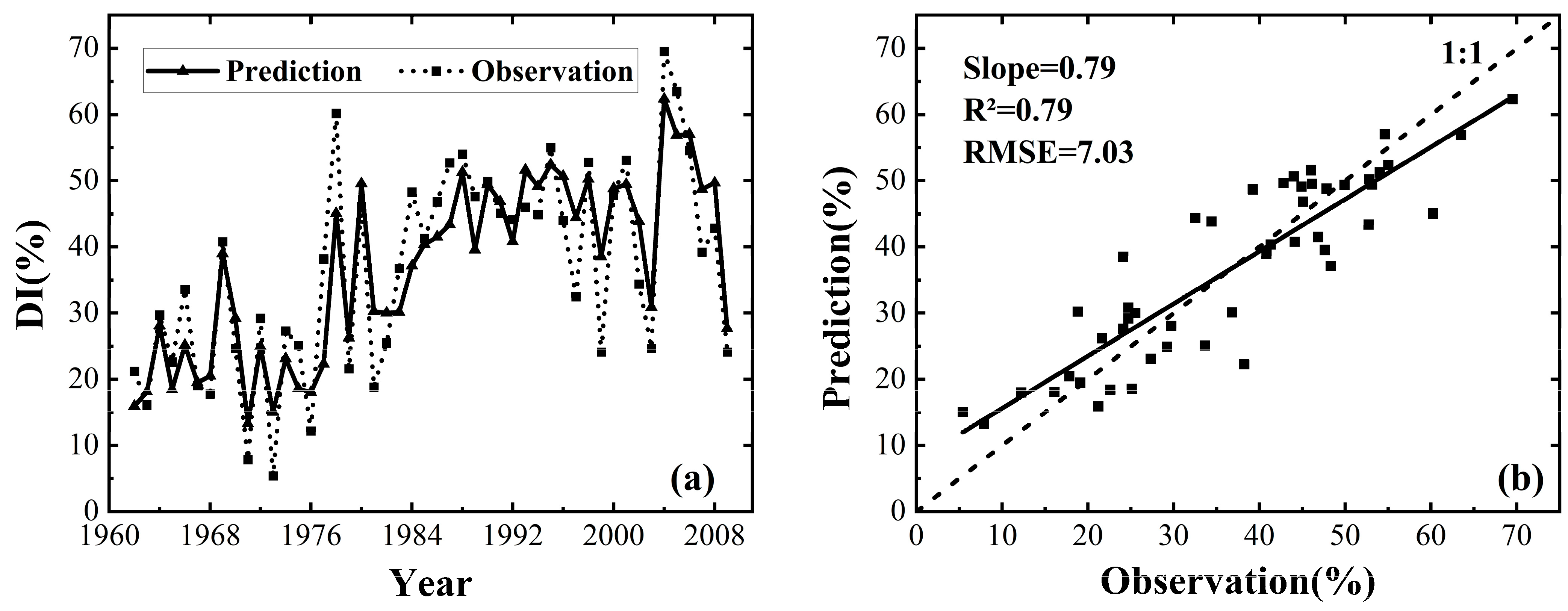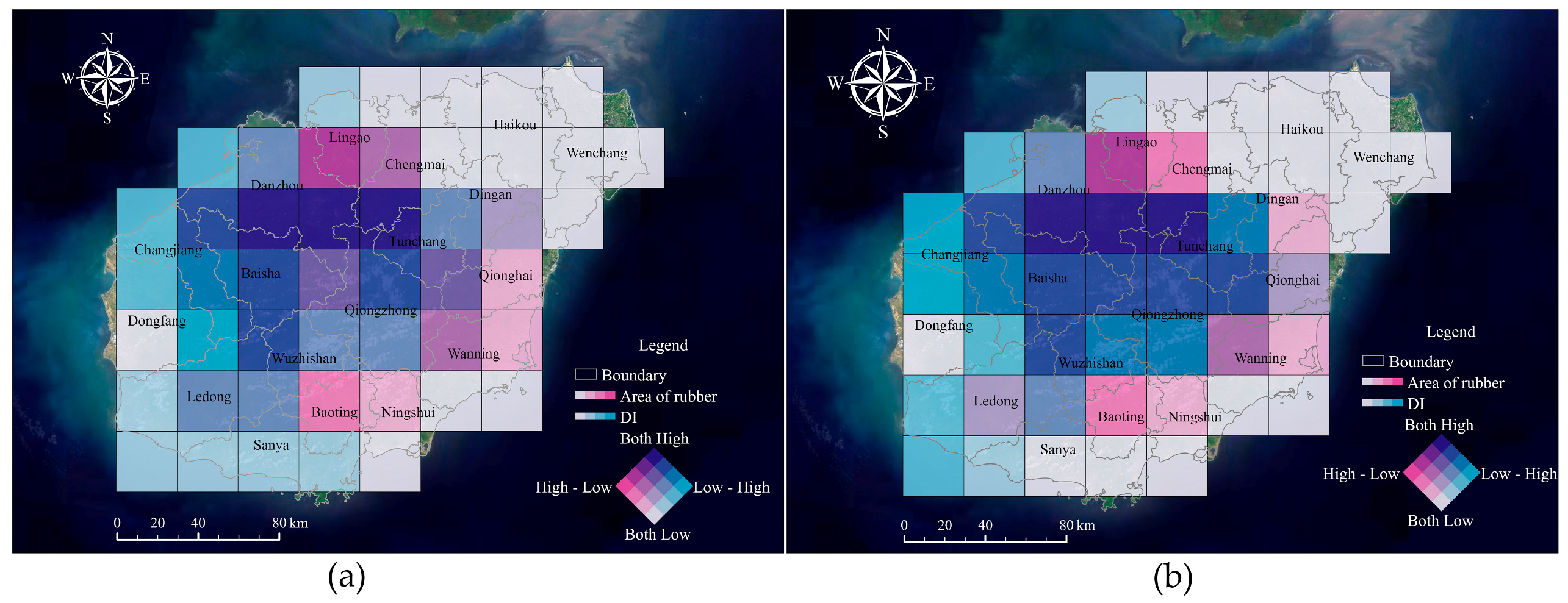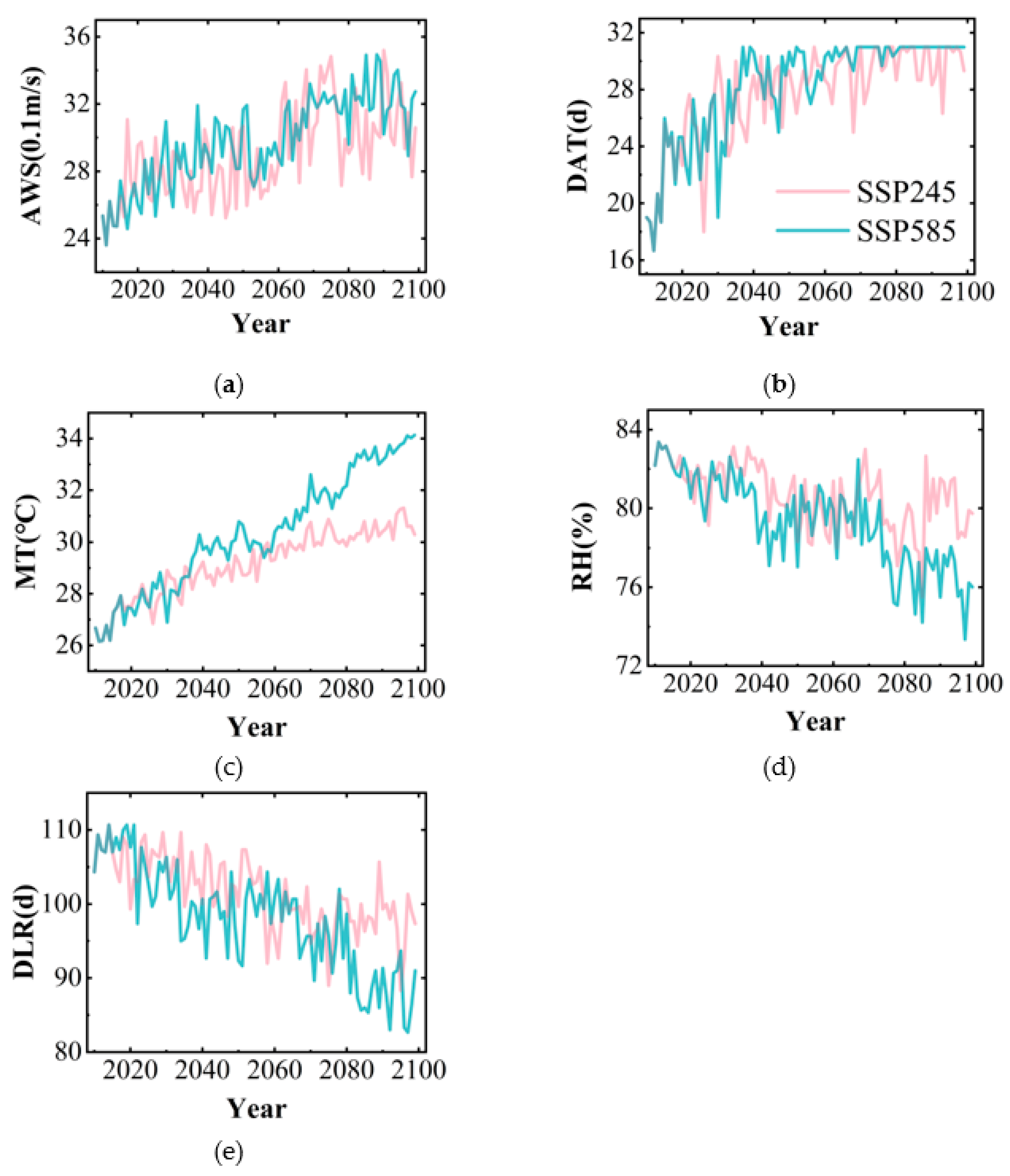Meteorological Impacts on Rubber Tree Powdery Mildew and Projections of Its Future Spatiotemporal Pattern
Abstract
:1. Introduction
2. Data and Methodology
2.1. Study Area
2.2. Data
2.2.1. Disease Index of Rubber Tree Powdery Mildew (RTPM-DI)
2.2.2. Historical Climate Data
2.2.3. Climate Data from CMIP6
2.2.4. Rubber Area Map
2.3. Methodology
2.3.1. Structural Equation Model
2.3.2. Bias Correction Method
2.3.3. Bayesian-Optimized Least-Squares Boosted Regression Tree Ensembles (LSBoost-RTE)
2.4. Emerging Hot Spot Analysis
3. Results
3.1. The Results of Meteorological Data Calibration
3.2. Meteorological Attribution Analysis for RTPM
3.3. RTPM-DI Prediction Model
3.4. Spatial Analysis of Current RTPM
3.5. Projected Spatiotemporal Patterns of RTPM under Climate Change
4. Discussions
4.1. The Reliability of SEM Assessment Results
4.2. Meteorological Impacts on RTPM
4.3. Spatiotemporal Patterns of RTPM under Climate Change
4.4. Consistency of Climate Suitability of RTPM with Rubber Plantation Exposure
5. Conclusions
Supplementary Materials
Author Contributions
Funding
Institutional Review Board Statement
Data Availability Statement
Acknowledgments
Conflicts of Interest
References
- Liyanage, K.K.; Khan, S.; Mortimer, P.E.; Hyde, K.D.; Xu, J.; Brooks, S.; Ming, Z. Powdery mildew disease of rubber tree. Forest Pathol. 2016, 46, 90–103. [Google Scholar] [CrossRef]
- Li, G.Y.; Kou, W.L.; Chen, B.Q.; Wu, Z.X.; Zhang, X.C.; Yun, T.; Ma, J.; Sun, R.; Li, Y.; Chen, B.Q. Spatio-temporal changes of rubber plantations in Hainan Island over the past 30 years. J. Nanjing For. Univ. (Nat. Sci. Ed.) 2022, 47, 189–198. [Google Scholar] [CrossRef]
- Li, Y.Y.; Zhang, J.; Liu, C.L.; Yang, X.C.; Li, J. Research on extraction and spatial-temporal expansion of rubber forest in five provinces of northern laos based on multi-source remote sensing. Forest Res. 2017, 30, 709–717. [Google Scholar] [CrossRef]
- Priyadarshan, P.M. Ancillary Income Generations. In Biology of Hevea Rubber; Springer: Berlin/Heidelberg, Germany, 2017; pp. 215–218. [Google Scholar]
- Xiao, C.W.; Li, P.; Feng, Z.M. Monitoring annual dynamics of mature rubber plantations in Xishuangbanna during 1987–2018 using Landsat time series data: A multiple normalization approach. Int. J. Appl. Earth Obs. 2019, 77, 30–41. [Google Scholar] [CrossRef]
- Yang, X.L.; Zhou, B.T.; Xu, Y.; Han, Z.Y. CMIP6 evaluation and projection of temperature and precipitation over China. Adv. Atmos. Sci. 2021, 38, 817–830. [Google Scholar] [CrossRef]
- Beeley, F. Oidium heveae: Report on the 1933 outbreak of Hevea leaf mildew. J. Rubber Res. Inst. Malaya 1933, 5, 5–13. [Google Scholar]
- Fernando, T.M. Oidium leaf disease-the effect of environment and control measures on incidence of disease and atmospheric spore concentration. Q. J. Rubber Res. Inst. Ceylon 1971, 48, 100–111. [Google Scholar]
- Lim, T.M.; Rao, B.S. An epidemiological approach to the control of oidium secondary leaf fall of Hevea. In Proceedings of the International Rubber Conference, Kuala Lumpur, Malaysia, 20 October 1975. [Google Scholar]
- Liyanage, A.S. Influence of some factors on the pattern of wintering and on the incidence of Oidium leaf fall in clone PB 86. Rubber Res. Inst. Sri Lanka 1976, 53, 31–38. [Google Scholar]
- Liyanage, S.; JACOB, C.K. Diseases of economic importance in rubber. In Developments in Crop Science; Elsevier: Amsterdam, The Netherlands, 1992; Volume 23, pp. 324–359. [Google Scholar]
- Peries, O. Present states and methods of control of leaf and panel diseases of Hevea in South East Asian and African countries. Q. J. Rubb. Res. Inst. Ceylon 1966, 42, 35–47. [Google Scholar]
- Bai, R.; Li, N.; Chen, H.L.; Liu, S.J.; Chen, X.M.; Zou, H.P. Influences of atmospheric circulation index and surface meteorological elements on the rubber tree powdery mildew in Hainan Province. J. Plant Prot. 2019, 46, 770–778. [Google Scholar] [CrossRef]
- Bai, R.; Wang, J.; Li, N. Climate change increases the suitable area and suitability degree of rubber tree powdery mildew in China. Ind. Crops Prod. 2022, 189, 115888. [Google Scholar] [CrossRef]
- Cao, X.; Xu, X.; Che, H.; West, J.; Luo, D. Effects of temperature and leaf age on conidial germination and disease development of powdery mildew on rubber tree. Plant Pathol. 2021, 70, 484–491. [Google Scholar] [CrossRef]
- Liyanage, A.S.; Peries, O.S.; Dharmaratne, A.; Fernando, B.; Irugalbandara, Z.E.; Wettasinghe, S.; Wettasinghe, P.C. Biology of Oidium heveae, the powdery mildew fungus of Hevea brasiliensis. In Proceedings of the International Rubber Conference 1985: Proceedings, Kuala Lumpur, Malaysia, 21–25 October 1985; Rubber Research Institute of Malaysia: Kuala Lumpur, Malaysia, 1986. [Google Scholar]
- Peries, O.S. Recent developments in the control of the diseases of the Hevea rubber tree. Rubber Res. Inst. Ceylon 1965, 41, 33–43. [Google Scholar]
- Yarwood, C.E. Powdery mildews. Bot. Rev. 1957, 23, 235–301. [Google Scholar] [CrossRef]
- Yu, T. Epidemic law and control techniques of rubber tree powdery mildew. Nong Min Zhi Fu Zhi You 2016, 175. Available online: https://kns.cnki.net/kcms2/article/abstract?v=3uoqIhG8C44YLTlOAiTRKibYlV5Vjs7iAEhECQAQ9aTiC5BjCgn0Rkk4dZ69Qxxsdf_zsfJEb2rCkJ5YrKlTCSoij1e3VGk_&uniplatform=NZKPT (accessed on 1 June 2023).
- Cao, X.R.; Che, H.Y.; Luo, D.Q. The effect of temperature on the occurrence of rubber tree powdery mildew. In Proceedings of the 2018 Annual Academic Conference of the Chinese Plant Protection Society and the Plant Protection Science and Technology Award Ceremony, Xi’an, China, 24 October 2018; p. 76. [Google Scholar]
- Shao, Z.Z.; Zhou, J.J.; Chen, J.X.; Li, Z.C.; Meng, Y.C. Study on the epidemic speed of rubber tree powdery mildew. J. Yunnan Trop. Crops Sci. Technol. 1996, 19, 2–12. [Google Scholar]
- Zhai, D.L.; Thaler, P.; Luo, Y.Q.; Xu, J.C. The powdery mildew disease of rubber (Oidium heveae) is jointly controlled by the winter temperature and host phenology. Int. J. Biometeorol. 2021, 65, 1707–1718. [Google Scholar] [CrossRef] [PubMed]
- Zhai, D.L.; Wang, J.; Thaler, P.; Luo, Y.Q.; Xu, J.C. Contrasted effects of temperature during defoliation vs. refoliation periods on the infection of rubber powdery mildew (Oidium heveae) in Xishuangbanna, China. Int. J. Biometeorol. 2020, 64, 1835–1845. [Google Scholar] [CrossRef] [PubMed]
- Byrne, J.M.; Hausbeck, M.K.; Shaw, B.D. Factors affecting concentrations of airborne conidia of Oidium sp. among poinsettias in a greenhouse. Plant Dis. 2000, 84, 1089–1095. [Google Scholar] [CrossRef]
- Willocquet, L.; Berud, F.; Raoux, L.; Clerjeau, M. Effects of wind, relative humidity, leaf movement and colony age on dispersal of conidia of Uncinula necator, causal agent of grape powdery mildew. Plant Pathol. 1998, 47, 234–242. [Google Scholar] [CrossRef]
- Cai, Z.Y.; Shi, Y.P.; Jiang, G.Z.; Liu, Y.X.; Zhang, C.S.; Xiong, Y.L.; Wang, J.Q.; Guo, H.; Ning, L.Y.; Li, G.H. Investigation and causes analysis of rubber powdery mildew and its comtrolling suggestions in Xishuangbanna region in 2017. China Plant Prot. 2018, 38, 29–33. [Google Scholar]
- Wastie, R.L. Diseases of rubber and their control. PANS Pest Artic. News Summ. 1975, 21, 268–288. [Google Scholar] [CrossRef]
- Wastie, R.; Mainstone, B. Economics of controlling secondary leaf fall of Hevea caused by Oidium heveae Steinm. Rubber Res. Inst. Malaya J. 1969, 64–72. Available online: https://www.cabidigitallibrary.org/doi/full/10.5555/19701104177 (accessed on 25 July 2023).
- Bana, J.K.; Choudhary, J.S.; Ghoghari, P.D.; Sharma, H.; Kumar, S.; Patil, S.J. Influence of weather parameters on powdery mildew of mango inflorescence in humid tropics of South Gujarat. J. Agrometeorol. 2020, 22, 488–493. [Google Scholar] [CrossRef]
- Bhatia, A.; Chug, A.; Prakash Singh, A. Application of extreme learning machine in plant disease prediction for highly imbalanced dataset. J. Stat. Manag. Syst. 2020, 23, 1059–1068. [Google Scholar] [CrossRef]
- Cortiñas Rodríguez, J.A.; González-Fernández, E.; Fernández-González, M.; Vázquez-Ruiz, R.A.; Aira, M.J. Fungal diseases in two north-west Spain vineyards: Relationship with meteorological conditions and predictive aerobiological model. Agronomy 2020, 10, 219. [Google Scholar] [CrossRef]
- Bhatia, A.; Chug, A.; Singh, A.P.; Singh, R.P.; Singh, D. A Forecasting Technique for Powdery Mildew Disease Prediction in Tomato Plants. In Proceedings of the Second Doctoral Symposium on Computational Intelligence, Lucknow, India, 6 March 2021; pp. 509–520. Available online: https://link.springer.com/chapter/10.1007/978-981-16-3346-1_41 (accessed on 29 July 2023).
- Carisse, O.; Fall, M.L. Decision trees to forecast risks of strawberry powdery mildew caused by Podosphaera aphanis. Agriculture 2021, 11, 29. [Google Scholar] [CrossRef]
- Chen, M.; Brun, F.; Raynal, M.; Makowski, D. Forecasting severe grape downy mildew attacks using machine learning. PLoS ONE 2020, 15, e0230254. [Google Scholar] [CrossRef] [PubMed]
- Fenu, G.; Malloci, F.M. Forecasting plant and crop disease: An explorative study on current algorithms. Big Data Cogn. Comput. 2021, 5, 2. [Google Scholar] [CrossRef]
- Hamer, W.B.; Birr, T.; Verreet, J.A.; Duttmann, R.; Klink, H. Spatio-temporal prediction of the epidemic spread of dangerous pathogens using machine learning methods. Isprs. Int. J. Geo-Inf. 2020, 9, 44. [Google Scholar] [CrossRef]
- Yang, H.; Hu, Y.Y.; Zhang, Y.; Wang, L.F. Present situation and application prospects of powdery mildew prediction technology of Hevea brasiliensis muell. Arg. Mol. Plant Breed. 2022, 1–19. [Google Scholar] [CrossRef]
- Ye, J.Q.; Liu, W.B.; Lin, C.H.; Zheng, F.C.; Miu, W.G. Establishment of prediction model of rubber powdery mildew based on artificial neural network. Southwest China J. Agri. Sci. 2020, 33, 797. [Google Scholar] [CrossRef]
- Bao, Y.B.; Na, L.; Han, A.; Guna, A.; Wang, F.; Liu, X.P.; Zhang, J.Q.; Wang, C.Y.; Tong, S.Q.; Bao, Y.H. Drought drives the pine caterpillars (Dendrolimus spp.) outbreaks and their prediction under different RCPs scenarios: A case study of Shandong Province, China. Forest Ecol. Manag. 2020, 475, 118446. [Google Scholar] [CrossRef]
- Geng, T.; Cai, W.J.; Wu, L.X.; Santoso, A.; Wang, G.J.; Jing, Z.; Gan, B.; Yang, Y.; Li, S.J.; Wang, S.P. Emergence of changing central-pacific and eastern-pacific El niño-southern oscillation in a warming climate. Nat. Commun. 2022, 13, 6616. [Google Scholar] [CrossRef]
- Moon, S.; Ha, K.J. Future changes in monsoon duration and precipitation using CMIP6. npj Clim. Atmos. Sci. 2020, 3, 45. [Google Scholar] [CrossRef]
- Sreeparvathy, V.; Srinivas, V.V. Meteorological flash droughts risk projections based on CMIP6 climate change scenarios. npj Clim. Atmos. Sci. 2022, 5, 77. [Google Scholar] [CrossRef]
- Cai, W.J.; Ng, B.; Wang, G.J.; Santoso, A.; Wu, L.X.; Yang, K. Increased ENSO sea surface temperature variability under four IPCC emission scenarios. Nat. Clim. Chang. 2022, 12, 228–231. [Google Scholar] [CrossRef]
- Carvalho, D.; Rafael, S.; Monteiro, A.; Rodrigues, V.; Lopes, M.; Rocha, A. How well have CMIP3, CMIP5 and CMIP6 future climate projections portrayed the recently observed warming. Sci. Rep. 2022, 12, 11983. [Google Scholar] [CrossRef] [PubMed]
- Gründemann, G.J.; van de Giesen, N.; Brunner, L.; van der Ent, R. Rarest rainfall events will see the greatest relative increase in magnitude under future climate change. Commun. Earth Environ. 2022, 3, 235. [Google Scholar] [CrossRef]
- Cui, W.; Xiong, Q.; Zheng, Y.Q.; Zhao, J.F.; Nie, T.Z.; Wu, L.; Sun, Z.Y. A study on the vulnerability of the gross primary production of rubber plantations to regional short-term flash drought over Hainan Island. Forests 2022, 13, 893. [Google Scholar] [CrossRef]
- Mo, Y.Y.; Yang, L. Global natural rubber industry situation in 2021 and prospect in 2022. Ind. Dev. 2022, 5–11+53. Available online: https://kns.cnki.net/kcms2/article/abstract?v=9CXCstbk-ttd-Yx3wGxOxZMilgyYT_MSodpqY9Q56-IqbxmdZi1itj5wvcoYOAkElModaaiigZEUwgI7IVWp8ysSjx1Fi2IKkm5zx9i95TgTs6K9hNHOQI16cPwEs-tzWxRbQO3sBXN75qu0wAgC7A==&uniplatform=NZKPT&language=CHS (accessed on 29 July 2023).
- Cao, X.; Che, H.; Yang, Y.; Luo, D. Relationships between ENSO and epidemics of powdery mildew of rubber tree in Hainan State Farm. Plant Prot. 2015, 41, 122–125. [Google Scholar] [CrossRef]
- Bolton, D. The computation of equivalent potential temperature. Mon. Weather Rev. 1980, 108, 1046–1053. [Google Scholar] [CrossRef]
- Kamruzzaman, M.; Shahid, S.; Islam, A.R.M.; Hwang, S.; Cho, J.; Zaman, M.; Uz, A.; Ahmed, M.; Rahman, M.; Hossain, M. Comparison of CMIP6 and CMIP5 model performance in simulating historical precipitation and temperature in Bangladesh: A preliminary study. Theor. Appl. Climatol. 2021, 145, 1385–1406. [Google Scholar] [CrossRef]
- Xiang, J.W.; Zhang, L.P.; Deng, Y.; She, D.X.; Zhang, Q. Projection and evaluation of extreme temperature and precipitation in major regions of China by CMIP6 models. Eng. J. Wuhan Univ. 2021, 54, 46–57. [Google Scholar] [CrossRef]
- Zhou, Y.C.; Zhang, Z.X.; Zhu, B.; Cheng, X.F.; Yang, L.; Gao, M.K.; Kong, R. Maxent modeling based on CMIP6 models to project potential suitable zones for Cunninghamia lanceolata in China. Forests 2021, 12, 752. [Google Scholar] [CrossRef]
- Bao, Q.G.L.; Zhang, R.Q.; Wang, Y.C.; Cui, W.; Zhao, J.F.; Wu, L.; Sun, Z.Y. A dataset of distribution changes of natural rubber plantations in Hainan Island from 2000 to 2020. China Sci. Data 2023, 8, 371–382. [Google Scholar] [CrossRef]
- Zhang, T.Y.; Chen, Z.; Zhang, W.K.; Jiao, C.C.; Yang, M.; Wang, Q.F.; Han, L.; Fu, Z.; Sun, Z.Y.; Li, W.H. Long-term trend and interannual variability of precipitation-use efficiency in Eurasian grasslands. Ecol. Indic. 2021, 130, 108091. [Google Scholar] [CrossRef]
- Zhang, T.Y.; Yu, G.R.; Chen, Z.; Hu, Z.M.; Jiao, C.C.; Yang, M.; Fu, Z.; Zhang, W.K.; Han, L.; Fan, M.M. Patterns and controls of vegetation productivity and precipitation-use efficiency across Eurasian grasslands. Sci. Total Environ. 2020, 741, 140204. [Google Scholar] [CrossRef]
- Das Gupta, S.; Pinno, B.D. Drivers of understory species richness in reconstructed boreal ecosystems: A structural equation modeling analysis. Sci. Rep. 2020, 10, 11555. [Google Scholar] [CrossRef]
- Jose, D.M.; Dwarakish, G.S. Bias Correction and trend analysis of temperature data by a high-resolution CMIP6 Model over a Tropical River Basin. Asia-Pac. J. Atmos. Sci. 2022, 58, 97–115. [Google Scholar] [CrossRef]
- Mendez, M.; Maathuis, B.; Hein-Griggs, D.; Alvarado-Gamboa, L.F. Performance evaluation of bias correction methods for climate change monthly precipitation projections over Costa Rica. Water 2020, 12, 482. [Google Scholar] [CrossRef]
- Mishra, V.; Bhatia, U.; Tiwari, A.D. Bias-corrected climate projections for South Asia from coupled model intercomparison project-6. Sci. Data 2020, 7, 338. [Google Scholar] [CrossRef] [PubMed]
- Déqué, M. Frequency of precipitation and temperature extremes over France in an anthropogenic scenario: Model results and statistical correction according to observed values. Glob. Planet. Chang. 2007, 57, 16–26. [Google Scholar] [CrossRef]
- Zheng, Z. Boosting and bagging of neural networks with applications to financial time series. Neural Netw. Univ. Chic. 2006. Available online: http://www-stat.wharton.upenn.edu/~steele/Courses/956/Resource/MachineLearning/ZZMLTrading.pdf (accessed on 20 May 2023).
- Bauer, E.; Kohavi, R. An empirical comparison of voting classification algorithms: Bagging, boosting, and variants. Mach. Learn. 1999, 36, 105–139. [Google Scholar] [CrossRef]
- Mendes-Moreira, J.; Soares, C.; Jorge, A.M.; Sousa, J.D. Ensemble approaches for regression: A survey. ACM Comput. Surv. 2012, 45, 1–40. [Google Scholar] [CrossRef]
- Friedman, J.H. Greedy function approximation: A gradient boosting machine. Ann. Stat. 2001, 29, 1189–1232. [Google Scholar] [CrossRef]
- Belsley, D.A.; Kuh, E.; Welsch, R.E. Identifying influential data and sources of collinearity. Regres. Diagn. 1980. Available online: https://books.google.com.hk/books?hl=zh-CN&lr=&id=GECBEUJVNe0C&oi=fnd&pg=PR7&dq=10.1002/0471725153&ots=bbc2eYbfB2&sig=bjhuBTRTHYCAolzGkXgGXFZBNBU&redir_esc=y#v=onepage&q&f=false (accessed on 10 December 2023). [CrossRef]
- Bousselma, A.; Abdessemed, D.; Tahraoui, H.; Amrane, A. Artificial intelligence and mathematical modelling of the drying kinetics of pre-treated whole apricots. Kem. Ind. 2021, 70, 651–667. [Google Scholar] [CrossRef]
- Deng, X.D.; Gao, F.; Liao, S.Y.; Liu, Y.; Chen, W.Y. Spatiotemporal evolution patterns of urban heat island and its relationship with urbanization in Guangdong-Hong Kong-Macao greater bay area of China from 2000 to 2020. Ecol. Indic. 2023, 146, 109817. [Google Scholar] [CrossRef]
- Gao, F.; Li, S.Y.; Tan, Z.Z.; Liao, S.Y. Visualizing the spatiotemporal characteristics of dockless bike sharing usage in Shenzhen, China. J. Geovis. Spat. Anal. 2022, 6, 12. [Google Scholar] [CrossRef]
- Ahmadi, H.; Argany, M.; Ghanbari, A.; Ahmadi, M. Visualized spatiotemporal data mining in investigation of Urmia Lake drought effects on increasing of PM10 in Tabriz using Space-Time Cube (2004–2019). Sustain. Cities Soc. 2022, 76, 103399. [Google Scholar] [CrossRef]
- Purwanto, P.; Utaya, S.; Handoyo, B.; Bachri, S.; Astuti, I.S.; Utomo, K.S.B.; Aldianto, Y.E. Spatiotemporal analysis of COVID-19 spread with emerging hotspot analysis and space–time cube models in East Java, Indonesia. Isprs. Int. J. Geo-Inf. 2021, 10, 133. [Google Scholar] [CrossRef]
- Yoon, J.; Lee, S. Spatio-temporal patterns in pedestrian crashes and their determining factors: Application of a space-time cube analysis model. Accid. Anal. Prev. 2021, 161, 106291. [Google Scholar] [CrossRef] [PubMed]
- Zhai, D.; Yu, H.; Chen, S.; Ranjitkar, S.; Xu, J. Responses of rubber leaf phenology to climatic variations in Southwest China. Int. J. Biometeorol. 2019, 63, 607–616. [Google Scholar] [CrossRef] [PubMed]
- Research Institute of Plant Protection, Southern China Academy of Tropical Agricultural Sciences. Study on the prevalence of rubber powdery mildew (1959–1981). Chin. J. Trop. Crops 1983, 4, 75–84. Available online: https://kns.cnki.net/kcms2/article/abstract?v=9CXCstbk-tsuZYg9bP3AzP_HhNXX0_WAAcWhmi1-90ULChZHOVN7RniKUXnrYuNcQCvqrp7xk6wYEANtV7vBvDKggZ9UuW20xApjl8rMxUadJST89QB1a7i96FYnuykCXJwBdzRC6Mo=&uniplatform=NZKPT&language=CHS (accessed on 6 November 2023).
- Yu, Z.T. Study on prediction and forecast of rubber tree powdery mildew (1960–1980). Chin. J. Trop. Crops 1985, 6, 51. [Google Scholar]
- Liu, Y.C.; Han, C.Y.; Lin, S.Y.; Li, J.C. PSN-aware circuit test timing prediction using machine learning. IET Comput. Digit. Tech. 2017, 11, 60–67. [Google Scholar] [CrossRef]
- Zhang, Y.; Xu, X.J. Solid particle erosion rate predictions through LSBoost. Powder Technol. 2021, 388, 517–525. [Google Scholar] [CrossRef]
- Zhang, Y.; Xu, X.J. Solubility predictions through LSBoost for supercritical carbon dioxide in ionic liquids. New J. Chem. 2020, 44, 20544–20567. [Google Scholar] [CrossRef]
- Zhang, Y.; Xu, X.J. Modulus of elasticity predictions through LSBoost for concrete of normal and high strength. Mater. Chem. Phys. 2022, 283, 126007. [Google Scholar] [CrossRef]
- Yazdandoost, F.; Moradian, S.; Izadi, A.; Aghakouchak, A. Evaluation of CMIP6 precipitation simulations across different climatic zones: Uncertainty and model intercomparison. Atmos. Res. 2021, 250, 105369. [Google Scholar] [CrossRef]
- Zhou, J.Q.; Huang, W.; Li, M.; Zheng, J.M.; Luo, M.; Fu, R. Dry-wet climate evolution feature and projection of future changes based on CMIP6 models in early summer over Yunnan province, China. Adv. Clim. Chang. Res. 2022, 18, 482. [Google Scholar] [CrossRef]
- McBride, L.A.; Hope, A.P.; Canty, T.P.; Bennett, B.F.; Tribett, W.R.; Salawitch, R.J. Comparison of CMIP6 historical climate simulations and future projected warming to an empirical model of global climate. Earth Syst. Dynam. 2021, 12, 545–579. [Google Scholar] [CrossRef]






| Model | Institution | Resolution |
|---|---|---|
| CanESM5 | Canadian Centre for Climate Modeling and Analysis, Victoria, BC, Canada | 5° |
| GFDL-ESM4 | NOAA Geophysical Fluid Dynamics Laboratory, Princeton, NJ, USA | 1° |
| MRI-ESM2-0 | Meteorological Research Institute, Tsukuba, Ibaraki, Japan | 1° |
| NorESM2-LM | Norwegian Climate Center, Drammen, Norway | 2.5° |
| Model | RMSE before Calibration | RMSE after Calibration | Correlation Coefficient before Calibration | Correlation Coefficient after Calibration |
|---|---|---|---|---|
| CanESM5 | 197.140 | 20.382 | 0.468 | 0.547 |
| GFDL-ESM4 | 215.383 | 10.024 | 0.567 | 0.683 |
| MRI-ESM2-0 | 212.979 | 22.571 | 0.348 | 0.862 |
| NorESM2-LM | 219.049 | 24.540 | 0.112 | 0.261 |
| Model | Relative Humidity | Precipitation | Average Wind Speed | Maximum Temperature | Average Temperature | |||||
|---|---|---|---|---|---|---|---|---|---|---|
| RMSE | MAE | RMSE | MAE | RMSE | MAE | RMSE | MAE | RMSE | MAE | |
| CanESM5 | 2.233 | 1.765 | 1.173 | 0.932 | 2.651 | 2.098 | 0.846 | 0.612 | 0.723 | 0.532 |
| GFDL-ESM4 | 2.693 | 2.154 | 1.322 | 1.006 | 2.862 | 2.323 | 0.580 | 0.430 | 0.487 | 0.362 |
| MRI-ESM2-0 | 2.402 | 1.956 | 1.347 | 1.122 | 2.704 | 2.116 | 0.666 | 0.543 | 0.607 | 0.488 |
| NorESM2-LM | 2.307 | 1.724 | 1.341 | 1.111 | 2.847 | 2.296 | 0.807 | 0.677 | 0.673 | 0.558 |
Disclaimer/Publisher’s Note: The statements, opinions and data contained in all publications are solely those of the individual author(s) and contributor(s) and not of MDPI and/or the editor(s). MDPI and/or the editor(s) disclaim responsibility for any injury to people or property resulting from any ideas, methods, instructions or products referred to in the content. |
© 2024 by the authors. Licensee MDPI, Basel, Switzerland. This article is an open access article distributed under the terms and conditions of the Creative Commons Attribution (CC BY) license (https://creativecommons.org/licenses/by/4.0/).
Share and Cite
Kong, J.; Wu, L.; Cao, J.; Cui, W.; Nie, T.; An, Y.; Sun, Z. Meteorological Impacts on Rubber Tree Powdery Mildew and Projections of Its Future Spatiotemporal Pattern. Agriculture 2024, 14, 619. https://doi.org/10.3390/agriculture14040619
Kong J, Wu L, Cao J, Cui W, Nie T, An Y, Sun Z. Meteorological Impacts on Rubber Tree Powdery Mildew and Projections of Its Future Spatiotemporal Pattern. Agriculture. 2024; 14(4):619. https://doi.org/10.3390/agriculture14040619
Chicago/Turabian StyleKong, Jiayan, Lan Wu, Jiaxin Cao, Wei Cui, Tangzhe Nie, Yinghe An, and Zhongyi Sun. 2024. "Meteorological Impacts on Rubber Tree Powdery Mildew and Projections of Its Future Spatiotemporal Pattern" Agriculture 14, no. 4: 619. https://doi.org/10.3390/agriculture14040619
APA StyleKong, J., Wu, L., Cao, J., Cui, W., Nie, T., An, Y., & Sun, Z. (2024). Meteorological Impacts on Rubber Tree Powdery Mildew and Projections of Its Future Spatiotemporal Pattern. Agriculture, 14(4), 619. https://doi.org/10.3390/agriculture14040619







